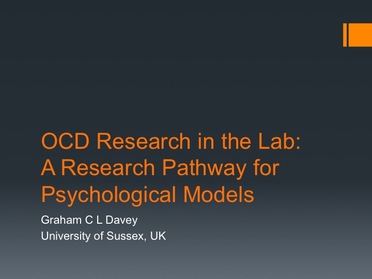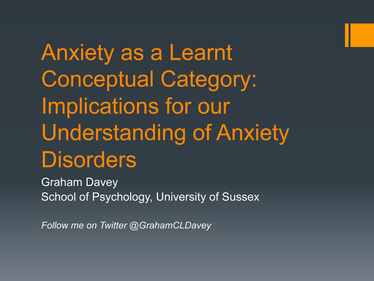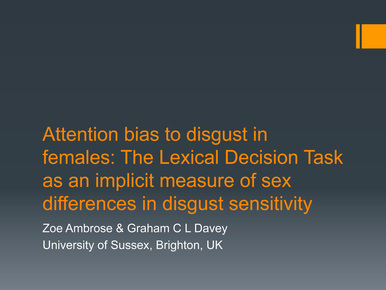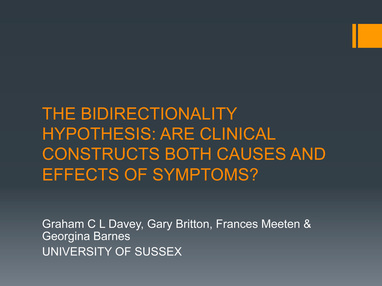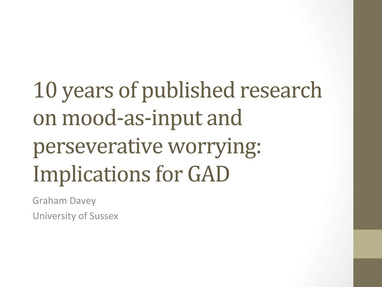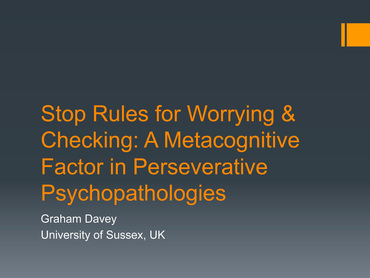
Conference Presentations, Book Chapters & Keynote Talks
Here's a selection of my recent Conference Presentations and Keynote Talks together with abstracts and PowerPoint presentations
Here's a selection of my recent Conference Presentations and Keynote Talks together with abstracts and PowerPoint presentations
Mechanisms of Disgust in Psychopathology
Graham Davey
Draft chapter to appear in Consedine N.S. & Powell P (Eds) (2021) The Handbook of Yuck: Modern Perspectives and Applications of Disgust Research. Springer.
While there have been significant advances in identifying the psychopathologies associated with disgust, and advances to some extent in understanding some of the developmental and cognitive characteristics associated with the disgust emotion (Knowles, Cox, Armstrong & Olatunji, 2019; Rottman, DeJesus & Greenebaum 2019), there has been less progress in clearly identifying the mechanisms by which the disgust emotion influences psychopathology symptoms – if, indeed, it does at all, and is not simply an epiphenomenon of the psychopathology symptoms it is associated with. In this chapter I will describe a number of putative mechanisms through which the emotion of disgust might influence the symptoms of mental health problems and examine how these putative mechanisms might fit the existing evidence on disgust-relevant psychopathologies.
Download Draft Chapter
Graham Davey
Draft chapter to appear in Consedine N.S. & Powell P (Eds) (2021) The Handbook of Yuck: Modern Perspectives and Applications of Disgust Research. Springer.
While there have been significant advances in identifying the psychopathologies associated with disgust, and advances to some extent in understanding some of the developmental and cognitive characteristics associated with the disgust emotion (Knowles, Cox, Armstrong & Olatunji, 2019; Rottman, DeJesus & Greenebaum 2019), there has been less progress in clearly identifying the mechanisms by which the disgust emotion influences psychopathology symptoms – if, indeed, it does at all, and is not simply an epiphenomenon of the psychopathology symptoms it is associated with. In this chapter I will describe a number of putative mechanisms through which the emotion of disgust might influence the symptoms of mental health problems and examine how these putative mechanisms might fit the existing evidence on disgust-relevant psychopathologies.
Download Draft Chapter
|
Why is Pathological Worrying Distressing?
Graham Davey Paper presented to the 2018 Annual Conference of the EABCT, Sofia, Bulgaria, September 2018 Distress is a defining feature of most mental health problems, but there are relatively few psychopathology models that focus directly on distress and attempt to identify the specific factors that generate that distress. This paper will discuss how experimental psychopathology research contributes to improving our understanding of what causes distress during pathological worrying and makes it qualitatively different to adaptive, everyday worrying. These factors include the automaticity of cognitive processes involved in worrying, negative thought intrusions, endemic negative mood during worrying, and the role of conflicting beliefs about worrying. |
Download PowerPoint Presentation
|
|
OCD Research in the Lab: A Research Pathway for Psychological Models
Graham Davey Position Paper presented to the EABCT Special Interest Group on OCD, Assisi, Italy, June 2016 This paper outlines a putative pathway for experimental psychopathology research developing psychological models of OCD. The pathway uses established external validity criteria to define the pathway and clarifies the important role that research conducted on healthy participants can play in our understanding of OCD. Defining a research pathway for experimental OCD research in this way has a number of benefits. It would (1) make explicit the need to address the external validity of developed models, (2) provide a clear programme of research that would be required to extend research on healthy individuals to populations with a diagnosis of OCD, and (3) recommend a closer reciprocal relationship between psychological models of OCD and existing core psychological knowledge. A structured research pathway for psychological models would help to provide a more robust (and fundable) alternative to other more medically-oriented paradigms such as neuroscience and genetics. |
Download PowerPoint Presentation
|
|
Mechanisms of Pathological Worry: What can Studies in the Lab tell us about Anxiety Disorders?
Graham Davey Invited Keynote presented to the one-day Conference on Anxiety, Southampton, September 2014 Experimental psychopathology is the use of experimental methods to study the psychological processes that either contribute to mental health problems or help to alleviate symptoms of mental health problems. In this paper I will outline reasons why experimental psychopathology is a necessary component of clinical psychology research, and describe some of the theoretical benefits of experimental psychopathology methods – especially in relation to the understanding of anxiety disorders. I will also argue that experimental psychopathology is an approach that is significantly under-used by clinical psychology researchers, and that clinical psychology research runs the risk of becoming insular and self-perpetuating if it fails to embrace experimental psychopathology. |
Download PowerPoint Presentation
|
|
10 Reasons why Clinical Psychology needs Experimental Psychopathology
Graham Davey Invited Keynote presented to the Rome Workshop on Experimental Psychopathology, Rome, February 2014 Experimental psychopathology is the use of experimental methods to study the psychological processes that either contribute to mental health problems or help to alleviate symptoms of mental health problems. In this paper I will outline reasons why experimental psychopathology is a necessary component of clinical psychology research, some of the theoretical benefits of experimental psychopathology methods, how it is an approach that is significantly under-used by clinical psychology researchers, and how clinical psychology research runs the risk of becoming insular and self-perpetuating if it fails to embrace experimental psychopathology. |

Download PowerPoint Presentation
|
|
Whatever happened to specific phobias? The significant contribution of Lars Goran Öst
Graham Davey Paper presented to the Annual Conference of the BABCP, London, July 2013
This paper will review the contribution of Lars Goran Öst to specific phobia research and treatment. The story begins in 1978 and covers all variety of specific phobias, including spiders, snakes, thunder, lightning, blood and dental phobia, claustrophobia, and flying phobia. His early contribution to aetiology was to highlight the various ways in which specific phobias could be acquired. His 1981 paper on this with Kenneth Hugdahl was one I carried around with me for some time, and had a significant impact on my own conceptualization of how phobias were acquired. More recently Lars Goran’s contribution has been to refine and evaluate brief exposure treatments for a range of phobic disabilities, and these will be briefly reviewed. I will end by asking why specific phobia research seems to have had a very low profile over the past 10 years – has Lars Goran Öst given us all the answers? |
Download PowerPoint Presentation
|
|
Aversive Intrusive Thoughts as Contributors to Inflated Responsibility, Intolerance of Uncertainty, and Thought-Action Fusion
Graham Davey & Frances Meeten Paper presented to the 3rd Meeting of the EABCT Special Interest Group on OCD, Assisi, May 2013
Three constructs considered to be important primary beliefs in the pathogenesis of OCD are inflated responsibility, intolerance of uncertainty and thought-action fusion. While there is evidence suggesting that these beliefs/appraisals can influence OCD symptoms, we conducted two experiments to determine whether manipulating aversive intrusive thoughts would conversely affect measures of these constructs. Using procedures in which nonclinical samples were asked to mentally rehearse either OCD-relevant aversive statements or neutral statements, Experiment 1 found that participants rehearsing aversive statements generated higher scores on measures of responsibility and thought-action fusion than a control condition. Experiment 2 found that rehearsing aversive statements facilitated measures of responsibility, intolerance of uncertainty and thought-action fusion, but only when rehearsal was self-referent. Rehearsing aversive statements significantly increased measures of negative mood, and mediational analyses suggested that the present findings could be explained either by increases in some measures of negative mood mediating the observed increases in appraisal ratings or alternatively, increases in some appraisal ratings increasing negative mood. These findings indicate that experiencing frequent, uncontrollable aversive intrusive thoughts of an egodystonic nature may activate OCD-relevant appraisal processes representing causal factors for symptoms, and directly tackling these thoughts in psychological interventions may be sufficient to alleviate anxiety symptoms. |
Download PowerPoint Presentation
|
Stop Rules: Mood and Perseverative Thinking
|
Download PowerPoint Presentation
|

